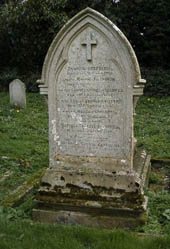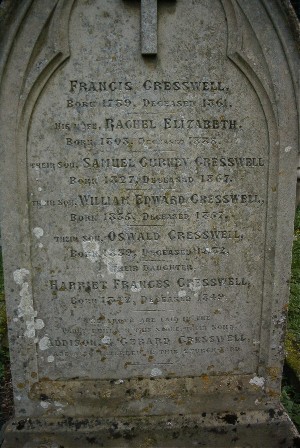 |
 |
Samuel Gurney Cresswell's gravestone is to the north east of the Church. Also buried here are his parents and siblings. Rachel Fry had stayed in North Runcton for many months in 1816. She was a rebellious daughter, perhaps resentful of her mother's devotion to her prison reform work, and the marriage to Captain Francis (Frank) Cresswell was a source of distress to Elizabeth Fry. Cresswell was not a member of the Society of Friends, so Quaker doctrine forbade Elizabeth attending her daughter's wedding, in August 1821. Samuel Gurney Cresswell went to sea at 14. By 1850 he had risen to the rank of Lieutenant and was on board the Investigator, which, with the Enterprise, set out to try to discover the fate of Sir John Franklin's expedition. |
 After
crossing the Atlantic and the Equator, they sailed west round
Cape Horn and proceeded up the west coast of the Americas, before
entering the arctic waters north of present day Alaska and Canada.
They made their way east, but became ice-bound. In fact, they
spent two arctic winters there (1850-51 and 1851-52) in very
inhospitable conditions. In the meantime a further four ships
were sent. In the summer of 1852, the crew of the Resolute,
approaching from the Atlantic side, discovered evidence of the
Investigator's location, which had been left at Winter
Harbour by a sledging party from the Investigator. Gurney
Cresswell was among a small party which transferred from the
Investigator to ships on the Atlantic side and returned
to Britain. This was the first time the NorthWest Passage had
been navigated, and the first complete circumnavigation of the
American continent.
After
crossing the Atlantic and the Equator, they sailed west round
Cape Horn and proceeded up the west coast of the Americas, before
entering the arctic waters north of present day Alaska and Canada.
They made their way east, but became ice-bound. In fact, they
spent two arctic winters there (1850-51 and 1851-52) in very
inhospitable conditions. In the meantime a further four ships
were sent. In the summer of 1852, the crew of the Resolute,
approaching from the Atlantic side, discovered evidence of the
Investigator's location, which had been left at Winter
Harbour by a sledging party from the Investigator. Gurney
Cresswell was among a small party which transferred from the
Investigator to ships on the Atlantic side and returned
to Britain. This was the first time the NorthWest Passage had
been navigated, and the first complete circumnavigation of the
American continent.
For the complete story of Samuel Gurney Cresswell's remarkable life, read War, Ice and Piracy by Dominick Harrod see book list